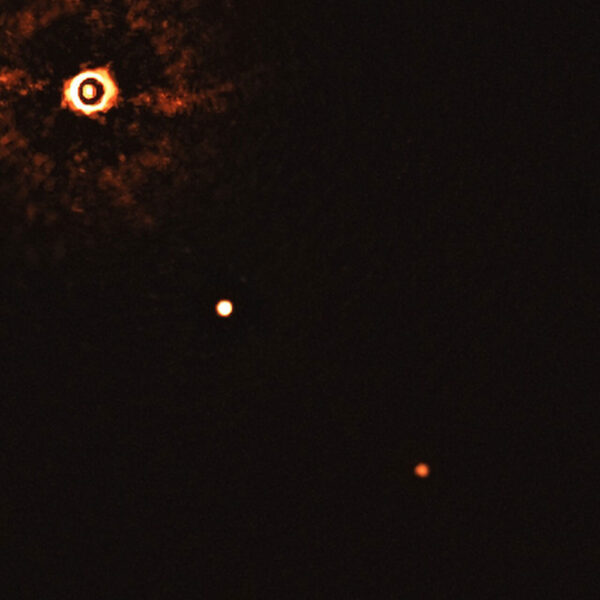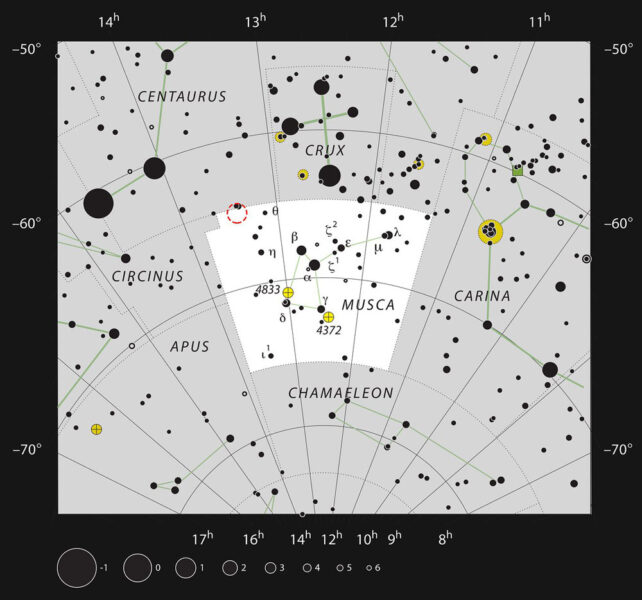For the first time, astronomers have imaged multiple planets orbiting a Sun-like star.
The European Southern Observatory's Very Large Telescope (VLT) has captured an image of a young, Sun-like star and its two companions. Direct images of exoplanets are nothing new, but this is the first time researchers have directly seen multiple planets orbiting a star like our own.

ESO / Bohn et al.
The star is only 17 million years old, a “very young version of our own Sun,” says Alexander Bohn (Leiden University, The Netherlands), who led the team that reported the results that will appear in Astrophysical Journal Letters (preprint available here).
But the system, dubbed TYC 8998-760-1, is nothing like our solar system. One of the star's companions straddles the line that defines planets, with a mass 14 times Jupiter's; the other has a mass of six Jupiters. Both orbit far from the star, about 160 and 320 times the average distance between Earth and the Sun. That puts them more than four times farther out than Pluto is from the Sun.
The Spectro-Polarimetric High-contrast Exoplanet Research (SPHERE) instrument on the VLT blocks the host star using a coronagraph, then uses a technique called polarimetery to further separate the starlight from the light coming from the planets. SPHERE images infrared radiation, so the light from these planets is not reflected starlight but rather the warm glow leftover from their formation.

Sky & Telescope / ESO
Perhaps it's not so surprising that the system is as strange as it is — SPHERE wouldn't have been able to image this system directly had it not been so young and the planets so far out. Nevertheless, the planets' orbital distance begs the question, did they form where they are? Or did they migrate to their current location?
In computer simulations, the researchers show that circular orbits at these distances are stable, but even mild elongations to the orbits would cause them to be unstable and therefore likely short-lived. So Bohn and his colleagues suggest that the planets probably formed in place, unless there was some very specific (and therefore less likely) scenario that ejected the planets to their far-out orbits.
 3
3









Comments
Anthony Barreiro
July 22, 2020 at 8:01 pm
I appreciate the star chart!
SIMBAD says that TYC 8998-760-1 has a parallax of 10.54 mas, which puts the star about 310 light years distant.
You must be logged in to post a comment.
Rod
July 23, 2020 at 10:14 pm
FYI. I went back and reviewed some reports in my home database on multiple giant planets reported in the news recently. The S&T report on exoplanets TYC 8998-760-1b and TYC 8998-760-1c, shows the first, multiple giant planet system that is directly imaged now (very cool, I like imaged binary stars and exoplanets). The parent star is 1 solar mass and said to be about 17E+6 years old, a very young solar analog star according to stellar evolution theory.
We have other reports of multiple giant planets too. These are not imaged (primary transit and radial velocity detections). WASP-148 (example, http://exoplanet.eu/catalog/wasp-148_b/) and Kepler-88 system, (http://exoplanet.eu/catalog/kepler-88_b/ as an example). Those bodies are more like hot jupiters or warm Neptunes, orbiting very close to their host stars with host star masses near one solar mass too. Kepler-88 host star is considered to be about 2.45E+9 years old . Kepler-88 and WASP-148 multiple giant exoplanet systems all orbit their host stars much closer than 1 AU compared to the TYC 8998-760-1 system imaged.
Consider a collapsing gas cloud and protoplanetary accretion disk model(s). We have our solar system configuration with a one solar mass star and a very habitable Earth. Now we see multiple giant exoplanets imaged around a star about one solar mass much farther away, and other multiple giant planets detected, orbiting around their host stars much closer than Mercury's orbit in our solar system. Those collapsing gas clouds work wonders in planet formation, considering the varieties reported now 🙂
You must be logged in to post a comment.
Rod
July 23, 2020 at 10:25 pm
The arcsecond for these two imaged giant exoplanets, at 95 pc distance, about 1.7" to 3.4" angular separation from the star for the AU reported. Very nice picture 🙂
You must be logged in to post a comment.
You must be logged in to post a comment.